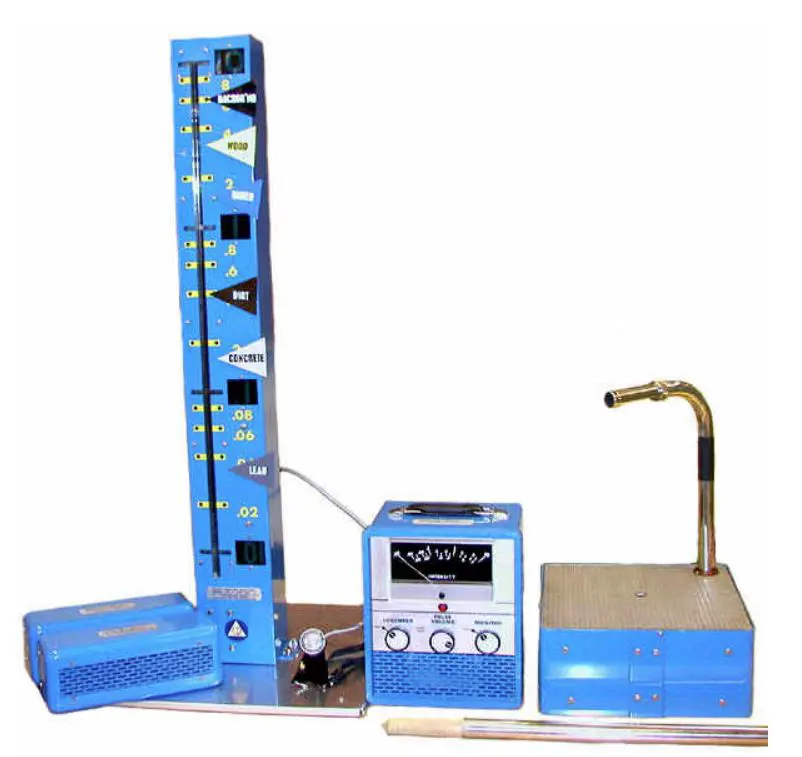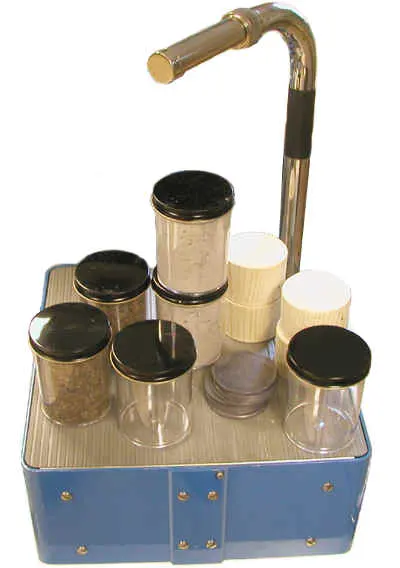
Radiation barrier shielding demonstrator from ORAU’s Museum of Radiation and Radioactivity
At the height of the Cold War in the 1960s, many American consumers were eager to buy radiation detectors and related equipment. The Office of Civil Defense (an agency of the U.S. Department of Defense) was swamped with calls from the public asking for tools for personal use. Since the government was not in the business to fill this need, several private companies jumped at the chance to fill the gap. Victoreen Instrument Company was one of those enterprises, and they produced a variety of products including this item on display in ORAU’s Museum of Radiation and Radioactivity. It was used for lectures and demonstrations, not personal use, but it scratched the itch of helping educate people on the best materials to protect against radiation exposure.
Officially, this product was known as CD V-757, a barrier shielding demonstrator. “CD” stands for civil defense. “V” is the company’s initial (Victoreen). And 757 is the model number. It was usually used in presentations given to law enforcement, firefighters, emergency responders, radiological defense personnel, and occasionally, the general public.
The set includes (from left to right in the picture): two remote speakers, the tower remote indicator, a portable microphone, instrument console, and the base unit with the Geiger Muller (GM) detector. An extension of the GM probe is in front of the monitor and platform. For more information about radiation survey instruments and GM detectors, visit our museum’s instrument page.

CD V-757 demonstrates radiation shielding with soil, concrete, wood, lead and empty jars to fill with water.
According to the Federal Emergency Management Agency publication Radiological Defense Manual (CPG 2-6.2), the CD V-757 was "a low-range radiation detection instrument coupled to a neon-lighted remote readout indicator that is readily visible in large conference rooms or small auditoriums. With the large indicator, a lecturer can show how radiation from a radioactive source is affected by distance and shielding.”
The person conducting the demonstration placed a small radioactive source (which required a license for possession and use!) inside the box platform. The platform has a hole in the middle, so the gamma rays from the source are emitted. A Geiger Muller tube is mounted directly over the hole. The demonstrator uses various materials to block the hole to the radioactive source.
The absorbing materials in this set consisted of lead disks, two plastic jars filled with concrete, two plastic jars filled with soil, two empty plastic jars (for water), and four cylinders of wood.

The CD V-757 display tower indicated how much ionizing radiation could be measured through different shielding materials.
Pop quiz! Which material do you think provides the best shielding from ionizing radiation?
Answer (listed from best to least protection): lead, concrete, water, soil, wood
This image shows the neon tube display of the remote indicator. As the detector's count rate increases, the neon light climbs up the logarithmic scale. The light is easily seen with the room lights on, but the photo was taken in the dark for the effect.
According to Radiological Instruments: An Essential Resource for National Preparedness (CPG 3-1), only 81 of these barrier-shielding demonstrator sets were procured. As of 1985, 55 of these were in state inventories, and 25 were in the federal inventory. ORAU is proud to own one of these sets. The radioactive source was removed when it was decommissioned.
Read more about this product in ORAU’s online Museum of Radiation and Radioactivity.
Reference material from Paul Frame, retired ORAU health physicist, trainer and curator of the Museum of Radiation and Radioactivity.